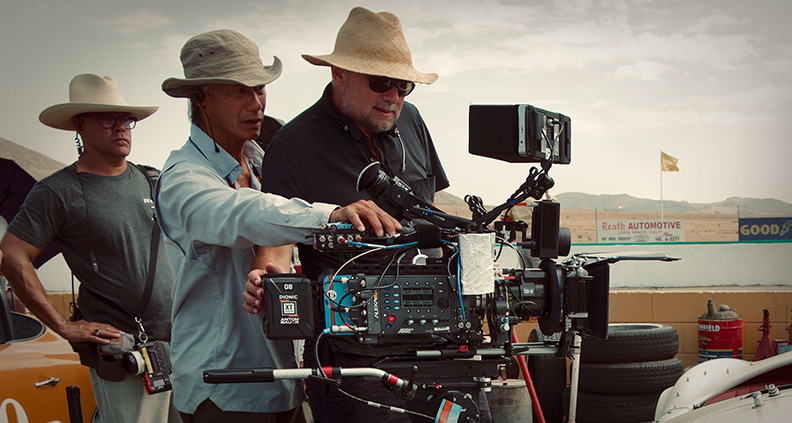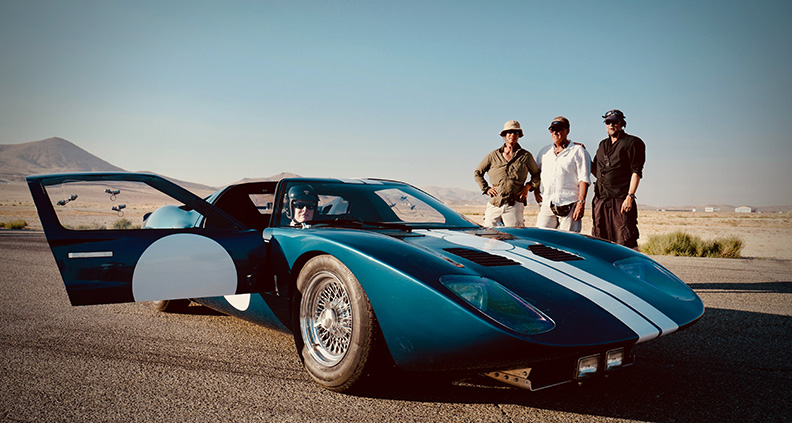DP Phedon Papamichael on the Vintage Look and Analog Action of ‘Ford v. Ferrari’
Movies are a mosaic of moving parts. But we don’t always see which parts, or who’s moving them. In Detail Oriented, Su Fang Tham explores some of the more specialized areas—and career paths—related to film production.
***
At a recent press screening for his new historical car racing drama Ford v. Ferrari on the Fox Studio lot in Century City, director James Mangold (Logan, Walk The Line) told the audience he was impressed that the studio had green-lit such a large-scale feature not tied to any sort of pre-existing IP. And Fox’s commitment to original storytelling paid off, with Manglod’s hit retelling—$91 million domestic box office and counting—of one of the most contentious tug-of-war sagas in auto racing history.
After Henry Ford II’s attempt to take over Italian luxury automaker Ferrari’s empire in 1963 birthed a decade-long rivalry, the 1966 24-hour Le Mans race marked the upstart American’s first real attempt to dethrone Enzo Ferrari, following Ferrari’s six consecutive Le Mans wins from 1960-1965. Ford turned to the only American who had won Le Mans—Texan automotive designer Carroll Shelby (Matt Damon). Shelby’s pick to pull off the Herculean task of building the Ford GT40? Mercurial-but-talented British racer/engineer Ken Miles (Christian Bale). The result is a 230/mph sports drama told through the lens of Miles and Shelby’s stirring friendship, which examines the emotional (and financial) toll that the racing life can take on a family.
In his fifth collaboration with Mangold, Oscar-nominated cinematographer Phedon Papamichael recently scored his fourth nomination at the prestigious cinematographer’s film festival Camerimage for his work on Ford v Ferrari. We recently caught up with him to learn what it took to create the concussive and kinetic racing sequences with 34 pod cars, and the benefits of shooting digital (vs film) for this project.
PHEDON PAPAMICHAEL

With all the technical demands of filming the racing scenes, how were you able to still focus on capturing the intimate moments of raw emotion between your main characters?
Papamichael: James and I have always approached the racing portion of the story—which covers almost an hour of screen time—as a tool to build dramatic tension. So it was about getting the cameras as physically up close to the actors as possible. Our focus was to put the audience in the POV of the drivers instead of using panning wide shots, like you would see in a sports broadcast or car commercial. Despite the technical requirements surrounding the racing sequences, the dramatic performance was still the key.
With so much going on in the racing scenes and shooting different portions of the same sequence in varying locations, did you have to storyboard part of it?
Papamichael: Not really. Instead, we let the actors rehearse and identify the dramatic moments, and then decide what the coverage needs to be. In a way, we approach it as if we’re shooting a play on stage. It’s similar to how I worked with [director] Alexander Payne on Nebraska and The Descendants.
How extensive was Previs used for the car sequences, especially for the Le Mans race portion of the story?
Papamichael: It was about 10 days of car-to-car work, and we had to build 34 cars. So we did a lot in Previs to budget and plan it all out. We shot most of the Le Mans sequences in Agua Dulce, CA, where we built a 300-yard long closed set. Some portions were filmed on country roads in Georgia with similar landscape as the countryside in central France [where the actual Le Mans race takes place]. The scene where Ken did the final test drive was shot in the Mojave Desert. Our focus was capturing as much as possible in-camera—we didn’t want to use any CG cars. Having Christian and Matt in those race cars really enhanced their performances because nothing created with hydraulics on a sound stage could possible replicate the intensity of the wind, sun and debris on the tracks. So we hard-mounted cameras to the cars to capture everything from the POV of the drivers. We never shot from the audience’s perspective.
Mangold has talked about maintaining the style and feel of the era without it coming off like a car commercial. How did you convey the sense of speed, especially with the spine-tingling hairpin turns at 230mph?
Papamichael: We could have used drones and aerial footage, but we really wanted to stay true to what technology existed at that time, more in line with films like Grand Prix (1966) and Steve McQueen’s Le Mans (1971). To achieve the look we were going for, the best way was to hard mount cameras onto the pod cars, which were cars that contained the actors but really driven by a stunt driver seated on a rig attached to the back. Inside the pod cars, you actually see Christian being tossed around as he reacts to the G-forces when the car tops 200+ mph. You see the cheeks fluttering and the body vibrating, which has this visceral effect. We wanted to do as little as possible on sound stages and with green screens in post, so we used wide lens close-ups that got very close to the car to fully transmit the sense of speed in wide-open areas. We also built a “Frankenstein car,” which was the pursuit car as the camera car.
You’ve shot your last few features digitally, particularly with the Arri Alexa cameras. What did you like about the Alexa LF for this film?
Papamichael: For this film, we used the large format lenses on the Alexa, I just love the way it renders. But I also wanted to use anamorphic lenses because I prefer that aspect ratio and the slight anamorphic distortion gives it that ’60s and ’70s grainy feel of film. However, these lenses are not designed to cover the full sensor on the Alexa LF. Fortunately, at Panavision, there’s a lens guru—Dan Sasaki [VP of Optical Engineering]. With only a week before principal photography, Dan built a prototype anamorphic lens for us that covers the expanded field of view on the LF and gave us the natural vignette-ing we were looking for.
What makes shooting on digital better than photochemical film?
Papamichael: With digital cameras like the Alexa, I can move faster in low light environments because it allows me to utilize more natural light. One example is the scene where Miles takes his son out onto the airport runway after sunset. We had a very short window of time at dusk to grab that low light sensitive shot. If that had been shot on film, it would’ve come out too grainy. Shooting on digital also allows you to take more chances because you have the director’s input in real-time. Even though I work more with digital now, if it fits the project, I still try to make it have that film aesthetic because I prefer that look. With the Alexa, the sensors have a very film-like curve/representation—it renders skin tone a more natural hue. You can also use expanded anamorphic lenses to make the images not as sharp and clean. On Ford, we used the Panavision C series of vintage lenses to achieve that look.
Would you ever go back to shooting on film? And what type of project would it take?
Papamichael: Definitely, it depends on the project. I recently shot a commercial on 16mm film.
What’s your advice to emerging cinematographers?
Papamichael: You have to find the directors with similar taste in aesthetics and projects. That’s why I’ve done five films with Mangold and four with Payne. I am actually self-taught—I never went to film school. This is going to sound counterintuitive, but don’t overeducate yourself. Have your camera in the right place at the right time and let the actors and the environment do the work. I’m a big believer in “instinctive filmmaking.”

Ford v. Ferrari is currently playing in theaters.
